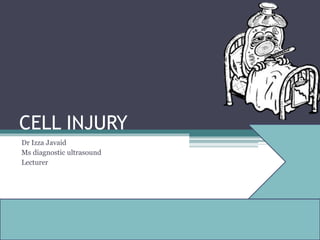
CELL INJURY.pptx
- 1. CELL INJURY Dr Izza Javaid Ms diagnostic ultrasound Lecturer
- 3. Adaptation When cells encounter physiological stresses of pathologic stimuli, they achieve an altered but steady state while preserving their health in the face of continued stress this is called adaptation. Examples of Cellular Adaptation • Atrophy • Hypertrophy • Hyperplasia
- 4. • Hypertrophy An increase in the size of an organ or tissue due to increase in the size of the cells e.g. increase in skeletal muscles mass associated with exercise and the enlargement of left ventricle in hypertensive heart disease. Number of cells remains the same. • Atrophy A decrease in the size of an organ or tissue resulting from a decrease in mass of preexisting cells e.g. tissue atrophy in the period of prolonged starvation or ischemia. Number of cells remains unchanged. • Hyperplasia. An increase in the size of any organ or tissue due to increase in number of cells e.g. uterine enlargement during pregnancy.
- 5. Cell injury When the limits of adaptive capacity are exceeded or when no adaptive response is possible, a consequence of events follows, termed as cell injury. The cell injury may be reversible or irreversible. • Reversible cell injury: It denotes pathologic changes that can be reversed when the stimulus (or stress) is removed or if the cause of injury is mild. • Irreversible cell injury: It denotes pathologic changes that are permanent and cause cell death.
- 7. Causes of cell injury • Нурохіа • Physical agents • Chemical agents • Microbiologic agents • Immunologic reactions • Genetic defects • Nutritional imbalances
- 8. Нурохіа It means lack of oxygen, which may be due to: • Ischemia (loss of blood supply) due to arterial occlusion • Inadequate oxygenation of blood secondary gag to pulmonary disease • Loss of oxygen carrying capacity of blood as in anemia or carbon monoxide poisoning • Decreased tissue perfusion as occurs is hypotension, shock and cardiac failure
- 9. • Physical agents: Trauma, radiation, electric shock Extremes of temperatures Sudden change in atmospheric pressure • Chemical agents: Glucose or salt in hypertonic concentration Oxygen in high concentration • Poisons e.g. arsenic, cyanide Insecticides, carbon monoxide, alcohol • Drugs • Microbiologic agents: Bacteria, viruses, fungi, parasites • Immunologic reactions: Anaphylactic reaction, autoimmune diseases shirt • Genetic defects: Congenital malformations, sickle cell anemia • Nutritional Imbalances: Hypovitaminosis, protein calorie malnutrition
- 10. MECHANISMS OF CELL INJURY Certain intracellular systems are particularly vulnerable to cell injury and different pathologic stimuli attack these systems through different mechanisms. These important systems are: • Maintenance of the integrity of cell membrane • Aerobic respiration and production of ATP • Synthesis of enzymes and structural proteins • Preservation of the integrity of the genetic apparatus These systems are closely related and thus injury to one system leads to wide ranging secondary effects.
- 11. There are several pathogenic mechanisms through which cell injury can take place. One or more than one of the following biochemical reactions may be involved. • Impaired cell membrane function • Decreased ATP (energy) production • Genetic alteration • Metabolic derangement
- 12. Impaired cell membrane function Following mechanisms can damage the cell membrane: • Production of free radicals • Loss of calcium homeostasis and increased intracellular calcium • Activation of complement system • Lysis by enzymes • Lysis by viruses, heat, cold and certain chemicals
- 13. Production of free radicals Oxygen derived free radicals are chemical species with a single unpaired electron in an outer orbit. When generated in cells, they rapidly attack and degrade nucleic acids and membrane molecules. In addition, free radicals initiate autocatalytic reactions. • Examples of free radicals are superoxide and hydrogen peroxide
- 15. Generation of free radicals Free radicals may be generated within cells by: • Normal metabolism (oxidation-reduction reactions) • Oxygen toxicity • Ionizing radiation (X-ray, ultraviolet rays) • Drug and chemicals • Cellular aging • Acute inflammation
- 16. Mechanism of cell injury by free radicals • Lipid peroxidation of membrane resulting in cellular and mitochondrial membrane damage • DNA damage • Loss of enzymatic activity by promoting cross- linking of proteins
- 17. Free radical degradation Once free radicals are formed, body has protective mechanism to get rid of them. The defense mechanism comprises: • Intracellular protective enzymes e.g. glutathione peroxidase, catalase, superoxide dismutase • Antioxidants e.g. vitamin E and C
- 18. Loss of calcium homeostasis and increased intracellular calcium Ischemia and certain toxins cause influx of calcium across the plasma membrane and release calcium from mitochondria and endoplasmic reticulum. This increased intracellular calcium activates phospholipases that degrade membrane phospholipids thus causing cell membrane damage
- 19. Activation complement system • Activation of complements C5b, C6, C7, C8 and C9 membrane • e.g. clostridium per fringes bacteria that damage the cell membrane.
- 20. Lysis by viruses, heat, cold, certain chemicals Effects of cell membrane damage a. Loss of structural integrity b. Loss of cellular function
- 21. Decreased ATP (energy) production • Hypoxia and hypoglycemia result in deficient ATP production. ATP is required for such important processes as membrane transport, protein synthesis, and phospholipid turnover.
- 22. Genetic alteration DNA in the chromosomes represents the genetic basis of control of cellular functions such as synthesis of structural proteins, growth regulating proteins and enzymes. DNA abnormalities may be inherited from generation to generation or acquired by any of several agents e.g. ionizing radiation, viruses, drugs and chemicals
- 23. Effects • Failure of synthesis of vital intracellular structural proteins • Failure of mitosis in actively dividing cells e.g. in bone marrow leads to anemia • Failure of growth-regulating proteins leads to cancer formation • failure of enzyme synthesis affects viral biochemical reactions
- 24. Metabolic derangemet Exposure to many exogenous injurious agents such as alcohol, drugs, heavy metals, infectious agents and accumulation of some endogenous substances can damage the cell.